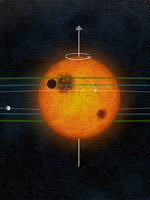

| Visitors Now: | |
| Total Visits: | |
| Total Stories: |

| Story Views | |
| Now: | |
| Last Hour: | |
| Last 24 Hours: | |
| Total: | |
Kepler Spots ‘Perfectly Aligned’ Alien Worlds
Astronomers have confirmed that our solar system isn’t unique, after the discovery of a planetary system that is as flat and orderly as our own.
That idea can be laid to rest thanks to an innovative use of the Kepler data which aligned three planets circling the Sun-like star Kepler-30 with a giant spot on the star’s surface. “The planets themselves are not all that remarkable – two giant Jupiters and one super-Earth – but what is remarkable is that they aligned so perfectly,” says astronomer Drake Deming of the University of Maryland When NASA’s Kepler space telescope started finding planets at odd angles to their parent stars, scientists wondered if our solar system’s tidy geometry, with the planets neatly orbiting around the Sun’s equator, was an exception to the rule. That finding is an indication that Kepler-30, like our own solar system, formed from a rotating disk of gas. The study showed the trio of planets orbiting within one degree, relative to each other and relative to the star’s equator.
“The dynamics of the system are important for the possible development of life,” he says.
The alignment of the Kepler-30 brood is the most precise found yet.
The Kepler telescope is studying about 150,000 Sun-like stars for signs of Earth-like planets. Multi-planet systems would have to be somewhat aligned to fall into the telescope’s narrow and deep field of view.
Kepler’s targets are all hundreds to thousands of light years away.
Future missions to probe stars closer to Earth most likely would need a wider-angle view, so using starspots as reference points could be a valuable tool for homing in on systems geometrically similar to ours.
“By chance, and because we have good data on our hands, we came up with the idea to measure obliquity (slant) with spots,” says lead researcher Roberto Sanchis-Ojeda of the Massachusetts Institute of Technology.
2012-08-25 03:34:19
Source: http://www.thesciencenews.info/2012/08/kepler-spots-perfectly-aligned-alien.html
Source:



